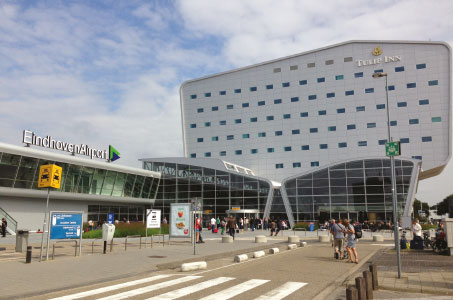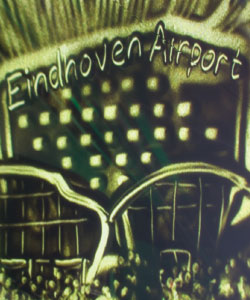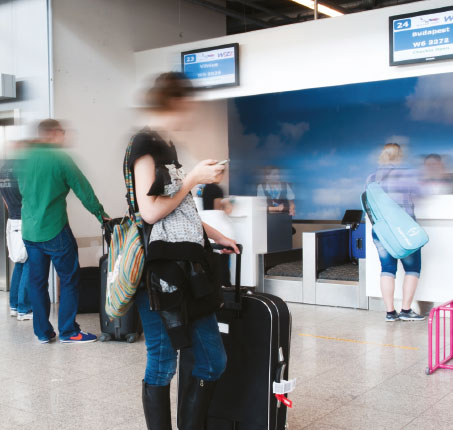
To cater for rapidly growing demand, Eindhoven Airport has refurbished and expanded its terminal, and also built a new airport hotel.

An official opening ceremony for the expanded terminal and new hotel was held last June and attended by almost 400 guests. The celebrations included an artist’s sand drawing of the new terminal.
While many European airports have struggled to register significant growth in recent years, Eindhoven Airport has seen its passenger throughput rise by +150% since 2006, when the airport handled less than 1.2 million passengers. The source of last year’s growth in traffic was three of Europe’s biggest low-cost carriers, notably Ryanair, transavia.com and Wizz Air.
To help cater for this rapidly growing demand, the airport has refurbished and expanded its terminal, and built a new airport hotel. On 21 June last year these were officially opened in a ceremony attended by almost 400 guests. State Secretary for the Ministry of Infrastructure and the Environment, Wilma Mansveld, performed the opening together with Joost Meijs, CEO of the airport, by adding the words “Hereby opened!” to an artist’s sand drawing of the new terminal. Speaking about the new development, State Secretary Mansveld said: “Travelling from Eindhoven, passengers can now reach 66 destinations, from Sweden to Morocco, and from Turkey to Ireland. In two years’ time, the airport has welcomed an additional one million passengers. This increase made it highly necessary to expand the terminal. It also gives a substantial impulse to the regional economy. Eindhoven can be proud of this.”

Eindhoven Airport has seen its passenger throughput rise by +150% since 2006, when the airport handled less than 1.2 million passengers. Eindhoven is the second busiest airport in the Netherlands, and handled a record 3.4 million passengers in 2013, up +14% on the previous year.
Eindhoven Airport’s rapid growth in recent years encouraged the airport to invest €26.5 million in the new development. In addition, retailers, caterers and other partner companies invested around €3 million in new shops and catering concepts. The complex construction project, which took about 19 months, went according to plan and budget and was realised while the airport remained open to the public. The development consists of several new areas. A new front zone of 2,000sqm with extra retail and catering facilities, a 2,700sqm expansion of the arrivals hall, 2,700sqm of extra office space, and the construction of the Tulip Inn Eindhoven Airport hotel with 120 rooms. The terminal has been completely refurbished in order to provide passengers with a quicker and more customer friendly service. To accomplish this, adjustments and expansions have been made to the baggage system, the gates, the check-in desks and the security lanes. The terminal now has the capacity to handle five million passengers, which it is hoped will be sufficient to cope with expected demand growth until at least 2020. The hotel and the new retail and catering facilities have created approximately 60 direct full-time jobs at the airport.
To optimise the customer experience within the new terminal, Eindhoven Airport developed a Customer Journey Strategy, in which digital communication plays a vital role. To plug into multiple moments of the customer journey, Eindhoven Airport developed digital initiatives that have proven to be innovative and in some cases a world’s first. At the beginning of last year, the Facebook VIP programme was launched, in order to offer VIP treatment for Facebook fans travelling from the airport, including Facebook branded parking spots at the entrance of the terminal.
Later, the airport partnered with Google to introduce Google Indoor Streetview, through which passengers can already orientate on the terminal and its facilities, lowering their stress curve. This year, it will launch mobile parking at the airport, offering passengers a way to pay for their parking spot through their smartphone, after they come back from their trip.
Environmental excellence
The development is fully in line with the sustainability ambitions of Eindhoven Airport. The hotel meets the demands of the international hallmark ‘Green Key’ label ‘Gold’ and energy label A++. The terminal has energy label A+. Sustainable building materials and energy-efficient lighting have been used, among other things, and PV panels and solar collectors have been installed on the roofs of the terminal and the hotel. According to Mansfeld: “The airport has an ambitious strategy in the field of sustainability and the reduction of carbon dioxide emissions, and I would like to compliment Eindhoven Airport on that, because Dutch aviation is good for our economy. The fact that this growth is balanced and managed with attention to the environment is even better news.”
These environmental initiatives saw Eindhoven become the first airport in the Benelux to obtain the highest level – Neutrality – under ACI EUROPE’s Airport Carbon Accreditation programme. Joost Meijs, CEO of Eindhoven Airport, commented: “Eindhoven Airport has the ambition to be one of the leading European airports in terms of sustainability. Airport Carbon Accreditation helps Eindhoven Airport realise this ambition.”
Eindhoven Airport is the main airport for the Brainport Eindhoven Region, which is the industrial high-tech heart of the Netherlands, founded on technology and design. Companies in the Brainport Eindhoven Region are responsible for nearly a third of all Dutch spending on research and development, and the region is home to leading campuses like the High Tech Campus Eindhoven, the Eindhoven University of Technology Campus and the High Tech Automotive Campus Helmond.
“Brainport deserves a modern airport as a gateway to Europe and as a calling card for hundreds of thousands of Europeans who visit the region via Eindhoven Airport every year. As a result of this development, we now have an airport with the right appeal for this ambitious region,” explained Meijs.
Ryanair services since April 2002, base since April 2013
Europe’s biggest low-cost carrier, Ryanair, has been serving Eindhoven since April 2002, when it launched its first route from London Stansted. Since then it has built up a network of over 30 routes from the airport. Finally, in April 2013 Ryanair made the airport an official base, locating one of its over 300 737-800s at the airport. This enabled it to add routes to Bordeaux in France, Chania in Greece, and Agadir and Fez, both in Morocco. Ryanair has announced that it will add three new routes this April – to Murcia, Corfu and Venice (Treviso).
Apart from Ryanair, the airport is also served by KLM’s low-cost subsidiary transavia.com, which offers a growing network of destinations across Europe.
The last recognised ‘full-service’ carrier to serve the airport was CityJet, which operated flights to London City Airport until the end of March 2013.







